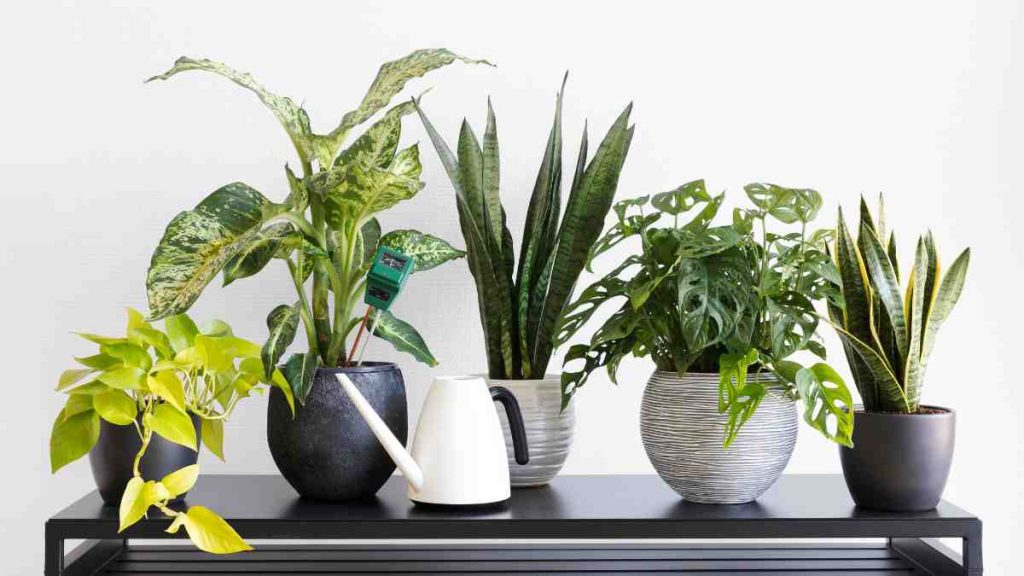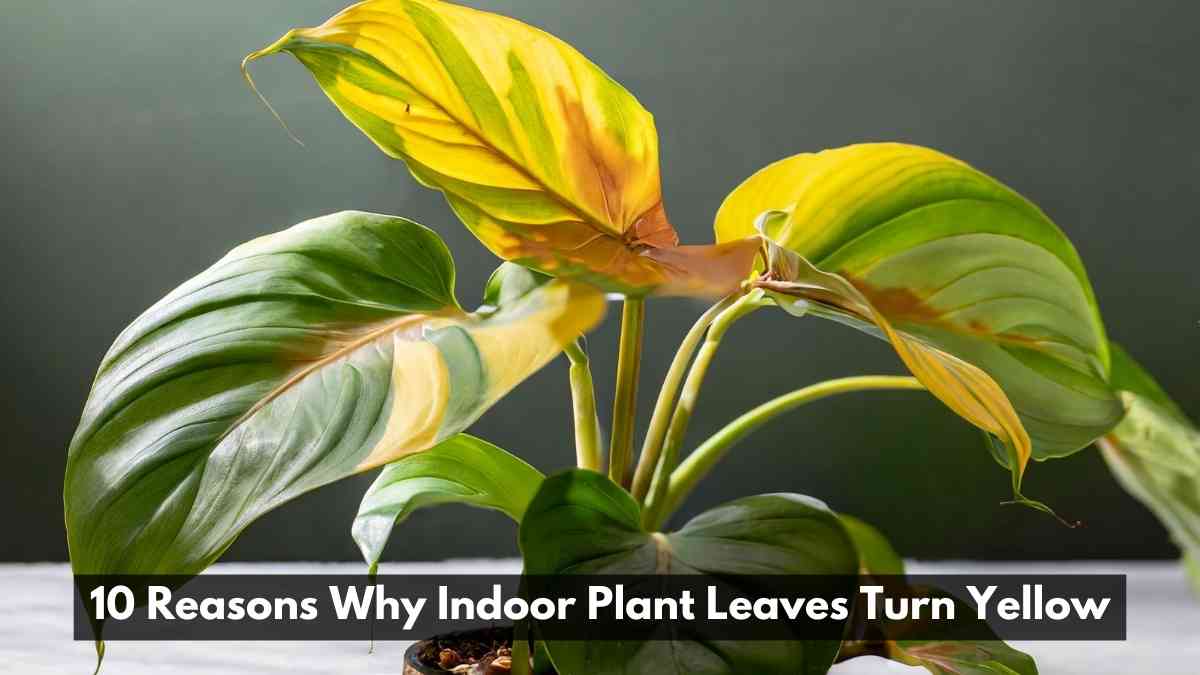As avid indoor gardeners, we understand the heartache that comes with watching those vibrant green leaves turn into a pale yellow hue. Fear not! We’re here to unveil the secrets behind this botanical mystery. Dive with us into the fascinating world of indoor plants as we decipher the 10 reasons why their leaves may undergo the enigmatic transformation to yellow.
Table of Contents
1. Inadequate Watering
One might think that watering plants is a straightforward task, but it’s a delicate dance between too much and too little. Let’s wade into the first chapter of our botanical journey and unravel the complexities of inadequate watering.
Overwatering
In the realm of indoor gardening, overwatering is a silent saboteur. Picture this: a waterlogged soil, suffocating the roots, depriving them of the much-needed oxygen. It’s akin to placing our leafy companions in a waterlogged prison, where even the most robust plants succumb to the drowning embrace of excess moisture.
To combat this, adopt a mindful watering routine. Check the soil moisture regularly, and allow it to dry out between waterings. Ensure your pots have proper drainage to prevent the roots from languishing in stagnant water.
Underwatering
On the flip side, underwatering is another villain in the saga of leaf-yellowing drama. When plants are deprived of their lifeblood, they become stressed and begin to exhibit signs of distress. Leaves lose their turgidity, wilting and ultimately turning yellow.
The remedy here lies in a consistent and adequate watering schedule. Get to know your plant’s specific needs, considering factors like its size, type, and environmental conditions. Remember, it’s a delicate equilibrium – finding the right balance ensures your plants flourish in a hydrated haven.

2. Lighting Woes
Now, let’s spotlight another critical act in our botanical drama – the play of light. Imagine your indoor plants as performers on a grand stage, each craving the perfect spotlight. But too much or too little can leave them in a state of horticultural disarray.
Insufficient Light
Inadequate light is akin to casting our leafy protagonists into the shadows. Picture a lush green plant slowly fading into a pallid yellow, yearning for the energy that sunlight provides. In the absence of sufficient light, essential processes like photosynthesis suffer, leaving the plant weakened and its leaves discolored.
To remedy this, strategically position your plants in areas with ample natural light. Know your plant’s light requirements – some thrive in bright, indirect light, while others demand the direct gaze of the sun. Consider supplementary artificial lighting for areas where natural light falls short, ensuring your green companions revel in their time in the limelight.
Excessive Light Exposure
On the opposite end of the spectrum lies the peril of excessive light exposure. It’s like subjecting our plants to a never-ending glare, leading to a different set of problems. Sunburned leaves, wilting, and a distinct yellowing of the foliage are telltale signs that your botanical buddies are feeling the heat – quite literally.
To shield them from this luminous onslaught, strategically place them away from intense, direct sunlight, especially during the scorching midday hours. Consider using sheer curtains or blinds to filter the light, providing a gentle and nurturing environment. Remember, moderation is key; find the perfect balance between light and shade for a visually stunning and healthy indoor garden.
3. Nutrient Deficiency
Now, let’s delve into the captivating world of nutrients – the sustenance that fuels the vibrant hues of our indoor greenery. Just as a well-balanced meal nourishes our bodies, plants too require their essential nutrients to flourish. Brace yourself as we uncover the impact of a lack of these vital elements.
Lack of Essential Nutrients
Imagine a banquet with a limited menu – no variety, no nutritional richness. In the plant kingdom, a lack of essential nutrients presents a similar scenario. Nitrogen, phosphorus, potassium, and an array of micronutrients are the building blocks for a healthy, green existence.
When these elements are scarce, plants resort to a desperate plea for help, and their leaves take on a yellowish tint, signaling a nutritional crisis. To counter this, become a nutritionist for your leafy companions. Choose a well-balanced fertilizer tailored to your specific plants, ensuring they receive the full spectrum of nutrients essential for robust growth.
Understanding the specific needs of your plants is crucial. Some, like heavy feeders, may require more frequent feeding, while others may thrive with a more minimalist approach. Think of it as crafting a gourmet meal plan for your botanical friends, custom-tailored to their unique appetites.
4. Soil Issues
Our botanical journey continues to the very foundation of plant life – the soil. Imagine the soil as the stage where our green performers root themselves, seeking a harmonious balance. However, poor soil conditions can lead to a dissonant symphony, with yellowing leaves as the melancholic melody. Let’s explore the drama of soil issues.
Poor Soil Drainage
Picture a saturated sponge – it may seem harmless at first, but when the roots of your beloved plants find themselves in waterlogged soil, it becomes a perilous predicament. Poor soil drainage restricts the flow of oxygen to the roots, leading to a cascade of issues, including yellowing leaves.
To rescue your green companions from this waterlogged abyss, ensure your pots have adequate drainage holes. Choose well-draining soil mixes, incorporating materials like perlite or sand. Regularly check the soil’s moisture levels, allowing it to dry out between waterings. By granting your plants the gift of well-aerated soil, you set the stage for a flourishing botanical performance.
Soil pH Imbalance
Now, let’s turn our attention to the pH level of the soil – the invisible conductor that influences the botanical harmony. An imbalanced pH can throw your plant’s world out of tune, triggering nutrient deficiencies and, consequently, yellowing leaves.
Test your soil’s pH regularly, aiming for levels that align with your specific plant’s preferences. Most indoor plants thrive in slightly acidic to neutral soil conditions. If your soil leans too far towards acidity or alkalinity, corrective measures can be taken. Amendments like lime or sulfur can help you recalibrate the pH, ensuring your plant’s roots dance to the right tune.

5. Pests and Diseases
Our journey through the verdant realms of indoor gardening encounters adversaries that lurk in the shadows pests and diseases. These silent invaders can turn your lush paradise into a battleground, leaving behind a trail of yellowed leaves. Join us as we unveil the menace of insect infestations and fungal infections, and how to safeguard your botanical sanctuary.
Insect Infestations
Imagine a microscopic army infiltrating your leafy fortress, sapping the life out of your prized plants. Insect infestations are a relentless assault that can manifest as yellowing leaves, distorted growth, and a weakened overall appearance.
Voracious pests like aphids, spider mites, and mealybugs can quickly overrun your indoor haven. Vigilance is your first line of defense. Regularly inspect the undersides of leaves and new growth for signs of infestation. Introduce natural predators like ladybugs or employ horticultural oils and insecticidal soaps to repel the invaders. Swift action is the key to reclaiming your green dominion from these miniature marauders.
Fungal Infections
Fungal infections, the stealthy infiltrators of the plant world, can cast a dark shadow over your botanical ensemble. Yellowing leaves, often accompanied by wilting or moldy growth, signal the insidious presence of fungi.
Maintaining proper air circulation and avoiding overwatering are crucial to prevent fungal outbreaks. If your plants fall prey to fungal woes, act promptly. Remove the affected foliage, ensuring to sterilize your pruning tools between cuts to prevent further contamination. Fungicides, both chemical and organic, can be employed as a last resort to halt the spread of the infection.
Related Article : How to Grow and Care for Chinese Peony
6. Temperature Extremes
Our botanical exploration now turns to the atmospheric ballet within your indoor garden – the temperature. While plants may seem resilient, they are sensitive souls that react dramatically to temperature extremes. Join us as we unravel the impact of extreme heat and the chilling embrace of cold stress, both of which can cast a pallor of yellow upon your leafy companions.
Extreme Heat
Imagine your plants sweltering under an unrelenting sun, leaves drooping, and colors fading like a watercolor left out in the sun. Extreme heat can push your green allies beyond their comfort zones, leading to stress and, inevitably, yellowing leaves.
Shield your plants from this horticultural sauna by strategically placing them away from direct sunlight during peak hours. Provide shade with curtains or blinds if needed. Adequate air circulation is also crucial, ensuring that your plants don’t find themselves trapped in a botanical furnace. Remember, moderation is key – find the temperature sweet spot that allows your indoor garden to thrive without succumbing to the fiery grasp of extreme heat.
Cold Stress
Now, let’s shift our focus to the other end of the thermic spectrum – the icy fingers of cold stress. Plants can shiver in response to sudden drops in temperature, leading to a symphony of yellow leaves as they struggle to cope.
Protect your leafy companions from the winter chill by keeping them away from drafty windows and doors. Consider adding a layer of insulation around pots during colder months. Water your plants with slightly warmer water to ease the shock of cold temperatures. A tropical escape for your indoor garden might be necessary, with additional heating sources to maintain a cozy environment.
7. Root Problems
Our botanical saga descends into the hidden realm beneath the soil – the domain of roots. The health of these subterranean warriors is paramount to the vitality of your indoor garden. Join us as we unearth the mysteries of root problems, where the insidious root rot and the constricting grip of compact or bound roots threaten to cast a pall over your leafy haven.
Root Rot
Envision the roots of your plants submerged in a watery grave, silently succumbing to a relentless foe – root rot. This insidious condition thrives in waterlogged soils, depriving the roots of oxygen and plunging them into a state of decay. The consequence? Yellowing leaves, a distress signal from the depths.
To combat this subaquatic menace, ensure proper drainage in your pots. Allow the soil to dry out between waterings, preventing the roots from languishing in a perpetual pool. Prune away affected roots and repot in fresh, well-draining soil. By thwarting the advances of root rot, you guarantee a vibrant and resilient root system, reflected in the verdant glory of your plant’s leaves.
Compact or Bound Roots
Now, shift your focus to a different subterranean drama – the claustrophobic embrace of compact or bound roots. Picture roots circling within the confines of a pot, struggling to expand. This constricting captivity can manifest in yellowing leaves, signaling the silent distress of the roots below.
To liberate your plants from this green imprisonment, periodically repot them into larger containers. Gently tease apart the roots to encourage outward growth. Trim any circling or tangled roots to stimulate a healthier, more robust root system. By giving your plants room to stretch their roots, you break the shackles that lead to yellowing leaves and breathe new life into your indoor garden.
8. Humidity Imbalances
In our horticultural odyssey, we now turn our attention to the often overlooked yet crucial factor – humidity. The delicate dance between high and low humidity can significantly influence the health of your indoor garden. Join us as we unravel the impact of humidity imbalances, where the whispers of both low and high humidity can echo in the yellowing leaves of your botanical haven.
Low Humidity
Picture your indoor plants in a desert of dry air, their leaves gasping for moisture like parched travelers. Low humidity can be a relentless antagonist, causing leaf edges to brown and curl, and the overall appearance to wilt into a palette of yellow.
To alleviate this botanical dehydration, introduce methods to elevate humidity levels. Group plants together to create a microclimate of increased moisture. Place water-filled trays or use a humidifier to add a refreshing mist to the air. Regularly misting your plant’s leaves can also provide a hydrating reprieve. By restoring moisture to the air, you ensure your green companions thrive in an oasis of lushness, their leaves radiant and free from the desiccating touch of low humidity.
High Humidity
On the flip side, imagine your indoor garden submerged in a humid embrace, the air thick and heavy. High humidity can foster a breeding ground for various leaf ailments, including fungal infections and pest infestations. Yellowing leaves, in this scenario, become the mournful notes in a symphony of botanical distress.
To combat the perils of excessive humidity, ensure proper air circulation by using fans or opening windows. Trim any overcrowded foliage to promote better airflow. If fungal issues arise, adjust watering practices to prevent waterlogged soil. By maintaining a delicate balance, you create an atmosphere where leaves radiate health, free from the burdens of both excessive and deficient humidity.

9. Chemical Exposure
Our botanical narrative takes a turn towards a less apparent yet potent adversary – chemical exposure. In the intricate dance of plant care, the introduction of harsh chemicals to water or soil can be a silent saboteur, leaving behind a trail of yellowed leaves. Join us as we unveil the perils of chemical exposure and how to safeguard your leafy companions from these horticultural hazards.
Harsh Chemicals in Water
Imagine your plants sipping from a chalice tainted with chemical residues, their leaves turning yellow in protest. Harsh chemicals in water, such as chlorine or fluoride, can disrupt the delicate balance within the plant, leading to nutrient deficiencies and visible signs of distress.
To shield your green allies, consider using filtered or dechlorinated water for watering. Allow tap water to stand for at least 24 hours before application, enabling harmful chemicals to dissipate. Regularly flush the soil with clean water to prevent the buildup of chemical residues. By purifying their watering source, you ensure your plants receive a pristine elixir, free from the toxic nuances of harsh chemicals.
Harsh Chemicals in Soil
Now, envision your plants rooted in soil laden with synthetic fertilizers or pesticides – a hostile environment that manifests in yellowing leaves. Harsh chemicals in the soil can disrupt the delicate symbiosis between roots and nutrients, leaving your leafy companions gasping for vitality.
Opt for organic and gentle fertilizers to nourish your plants, promoting a balanced and sustainable growth. If pesticides are necessary, choose those specifically formulated for indoor use and follow recommended application guidelines diligently. Periodically flush the soil with clean water to rid it of accumulated chemicals. By cultivating a chemical-free soil environment, you provide a sanctuary where roots can thrive, translating into vibrant, green leaves.
10. Age and Natural Shedding
In the grand tapestry of your indoor garden, a chapter often overlooked is the natural progression of age and the rhythmic ballet of seasonal leaf shedding. Understanding these inherent processes is key to interpreting the language of yellowing leaves, as they gracefully signal the cyclical journey within the life of your green companions.
Normal Aging Process
Envision your plants as wise elders, their older leaves gracefully fading into a golden spectacle. The normal aging process is a symphony of transition, where leaves mature, perform their photosynthetic duties, and then gracefully bow out. This natural lifecycle is marked by a subtle yellowing, a testament to the plant’s wisdom and resilience.
Instead of intervening, appreciate this botanical ballet. As leaves age, new growth emerges, ensuring a perpetual cycle of renewal. Regularly remove older leaves to redirect the plant’s energy to fresh growth. By embracing the gracefulness of the normal aging process, you contribute to the cyclical beauty of your indoor garden, where each yellowing leaf narrates a story of maturity and continuity.
Seasonal Leaf Shedding
Now, imagine your indoor garden in tune with the changing seasons, shedding leaves in a synchronized ballet of renewal. Seasonal leaf shedding is a harmonious response to shifts in light, temperature, and humidity. As winter surrenders to spring, older leaves gracefully fall, making way for new growth and a vibrant resurgence of greenery.
During these transitions, offer your plants a bit of extra care. Ensure they receive appropriate light, adjust watering routines, and provide a balanced fertilizer to support their regenerative efforts. As leaves fall, embrace the anticipation of the verdant revival that follows. By acknowledging the seasonal leaf shedding as a natural rhythm, you contribute to the resilience and continuity of your indoor jungle.
You May Also Like:




Leave a Reply